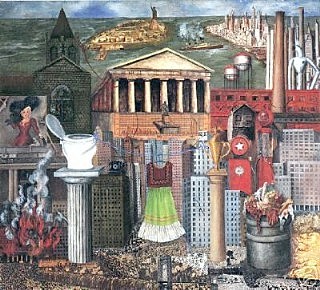My Dress Hangs There
1933
After more than three years in America, Frida wanted desperately to return to her native Mexico. Diego, however, remained fascinated by the country and his popularity and did not want to leave. Out of the conflict came this painting. The only collage in the artist's oeuvre, it represents an ironic portrait of American capitalism and superficiality. Filled with symbols of a modern American industrial society, it points to social decay and the destruction of fundamental human values. In this painting, Frida takes an opposite view to her husband, who was expressing his approval of industrial progress in a mural in the Rockefeller Center.
What is missing from this painting is the focal point of nearly all of Frida's paintings…herself. Instead, Frida's Tehuana dress hangs empty and alone amidst the chaos in the background. It may be her way of saying "I may be in America but only my dress hangs there…my life is in Mexico."
Frida started this painting while still in New York and finished it after she and Diego returned to Mexico. She signed this painting on the back in chalk and added the inscription: "I painted this in New York when Diego was painting the mural in Rockefeller Center".
The painting was given to Frida's trusted medical advisor Dr. Leo Eloesser of San Francisco. When Dr. Eloesser died in 1976, he willed the painting to his long time companion Joyce Campbell. In 1993, Campbell sold the painting just before there was a boom market for Kahlo's works.

(Click Here to View Larger Image)
(Pinche aquí para ver la imagen aumentada)
Oil
and collage on masonite
18" x 19 ¾"
Hoover Gallery,
San Francisco, California, U.S.A.
Óleo y collage sobre fibra dura
46 x 50 cm.
Galería
de Hoover,
San Francisco, California, EE.UU.
Allá cuelga mi vestido
1933
Después de más de tres años en América, Frida quería desesperadamente volver a su México nativo. Diego, no obstante estaba fascinado por el país y no quería irse. De ese conflicto surgió esta pintura. Este, el único collage en la obra de la artista, representa un retrato irónico del capitalismo Americano. Lleno de símbolos de una sociedad industrial moderna Americana, muestra la degeneración de la sociedad y la destrucción de los valores humanos fundamentales. En esta pintura, Frida toma un punto de vista opuesto al de su marido, que expresaba su aprobación del progreso industrial en un mural en el Rockefeller Center.
Lo que falta en esta pintura es el centro de casi todos sus cuadros...ella misma. En lugar de hacer su autorretrato, su vestido de Tehuana cuelga vacío en medio del caos que se ve en el fondo. Puede ser su manera de decir “Quizás estoy en América, pero solo mi vestido cuelga allá….mi vida está en México”
Frida empezó este cuadro cuando aun estaba en Nueva York y lo acabó después de que Diego y ella regresaran a México. Ella firmó esta pintura en la parte de atrás en tiza y añadió la inscripción: "Pinté esto en Nueva York mientras Diego estaba pintando el mural en el Rockefeller Center"
El cuadro fue regalado
a su consejero médico de Frida en el que ella tanto confiaba, el
Dr. Leo Eloesser de San Francisco. Cuando el Dr. Eloesser falleció
en 1976, le dejó el cuadro en herencia a su compañera de
muchos años, Joyce Campbell. En 1993, Campbell vendió el
cuadro, justo antes de que estallase el boom Kahlo en el mercado de arte.